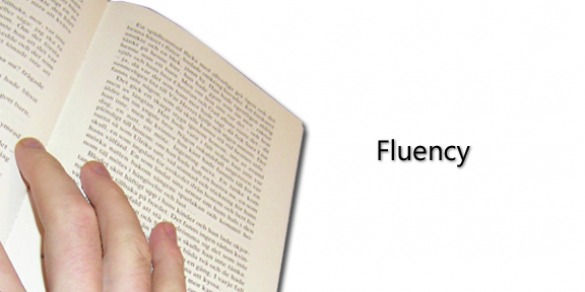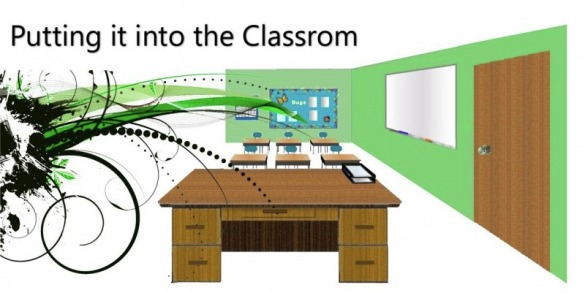the ability to read accurately, quickly, smoothly, naturally, expressively, in syntactical units, with phrasing, and fairly automatic and effortless.
Facts About Fluency:
- The three parts of fluency include: rate, prosody, and accuracy
- Educators believe that word recognition naturally lead to fluent reading.
- Some people say it is reading how you speak, but it is more about reading more fluidly.
- Teachers received little (if any) training in the topic of fluency.
- Fluency instruction begins when students can read connected text with 90% accuracy. This is usually by the middle of first grade.
- If a student misses more than 10% of the words in a passage, then the material is too difficult to use for instruction
- Some teachers favor comprehension over fluency and fluency over comprehension.
- Some students have developed accurate word pronunciation skills but read slowly
- Decoding is not automatic or fluent, and their limited fluency may affect performance
- They read less text than peers and have less time to remember, review, or comprehend the text
- They expend more cognitive energy than peers trying to identify individual words
- They may be less able to retain text in their memories and less likely to integrate those segments with other parts of the text
- Could be a cultural thing-which is why you test comprehension as well and not just the speed of the reading
- Many teachers have students who are not fluent readers yet have high comprehension levels.
Block, Meghan. (2010). Fluency. [PowerPoint Slides].
Retrieved from University of Michigan State.
Retrieved from University of Michigan State.
Why is it Important?
- Fluent readers are better able to devote their attention to comprehending text
- Students who experience reading difficulties are often dis-fluent
- Fluency instruction is generally effective, although it is unclear whether this is because of specific instructional features or because it involves children in reading increased amounts of text;
- Assisted approaches seem to be more effective than unassisted approaches;
- Repetitive approaches do not seem to hold a clear advantage over non-repetitive approaches
- Effective fluency instruction moves beyond automatic word recognition to include rhythm and expression, or what linguists refer to as the prosodic features of language.
These results were found by a study that tried to imporve
the fluency of struggling readers by Kuhn and Stahl in 2003
the fluency of struggling readers by Kuhn and Stahl in 2003
Calculating WCPM (Words Correct Per Minute)
Accuracy Rate
Calculating Self Correction Rate
- Total # of words read (in 1 min) - # of errors = WCPM
Accuracy Rate
- Correct number of words read / Total number of words read = Percent Accuracy
- Independent level = 95 - 100%
- Instructional level = 90 - 94%
- Frustration level = < 90%
Calculating Self Correction Rate
- (# of errors + # of self corrections) / # of self corrections = Self Corrected Rate
Connection Between Fluency and Comprehension:
- Accuracy/porosity vs. speed of reading
- Assessments like the DIBLES assessment: students try to read faster and faster and faster but don’t comprehend what they are reading. Sometimes they can read the word but they don’t know what it is so they get confused, and the fact that it’s supposed to be administered by someone other than their normal teacher can imitate the child, influencing the results of the test
- The ultimate goal needs to be comprehension
Block, Meghan. (2010). Fluency. [PowerPoint Slides].
Retrieved from University of Michigan State.
Retrieved from University of Michigan State.
Vocabulary Related to Fluency:
- Automacity:When we become fluent at a particular task, we can devote our attention to other related task. In the case of fluency, once we become more automatic readers, we can devote our attention to comprehension.
- Accuracy: When the student recognizes most of the words automatically, with little or no attention required for identifying words, even though some miscues will occur like mispronunciations, omissions, and insertions
- High Frequency Words: The most common words that occur over and over in the English language. These words can comprise over 60% of the words used in beginning reading materials and over 50% of the words used in materials used in the upper grades.
- Prosody: Reading with inflection or expression.
Block, Meghan. (2010). Fluency. [PowerPoint Slides].
Retrieved from University of Michigan State.
Retrieved from University of Michigan State.
Ways to Help Students Develop Fluency:
- Repeated reading of texts
- Feedback and guidance from teachers and family
- Teachers must match students’ reading levels to their instructional materials (students should not be reading at a frustration level).
- Teachers should model fluent and expressive reading every day in their read aloud materials.
- Teachers should provide amply opportunities for students to participate in guided, oral reading.
- Teachers should provide opportunities for students to read easy materials independently every day.
- Language Experience Approach (LEA) involves writing down what students say, then reading and rereading it with them to develop knowledge of letter-sound associations, sight words, prosody, and language.
- Readers Theater is a presentation of a text read aloud expressively and dramatically by two or more readers.
- Echo Reading involves the student immediately echoing or imitating the performance of a more skilled reader.
- Choral reading involves students reading text in unison.
- Phrase Boundaries involves clustering reading into appropriate phrases, rather than reading word by word.
- Paired Reading involves a more capable reader supporting a tutee in reading materials that are generally more difficult than those read independently.
- Neurological Impress Method involves the teacher and the student reading aloud simultaneously from the same book. The teacher reads slightly faster than the student to keep the reading fluent. The teacher usually sits next to the student and focuses his voice near the ear of the student.
- Repeated Reading involves students reading text while the teacher records the student’s fluency and accuracy. The student practices reading the passage orally or silently several times. After practicing, the teacher listens to the student read and again records the time and accuracy. The teacher and student compare pre and post results and graph growth using a chart.
- Computer Based or Tape Assisted Reading involves using computer or tape recorded text to assist and model reading for students.
Block, Meghan. (2010). Fluency. [PowerPoint Slides].
Retrieved from University of Michigan State.
Retrieved from University of Michigan State.
Second Language Learners (SLL)
- listening to models
- repeated readings
- choral reading
- partner reading
- repeated reading practice, especially in expository or informational texts
- more time on task
- paired reading and rereading
- additional feedback and progress monitoring
Block, Meghan. (2010). Fluency. [PowerPoint Slides].
Retrieved from University of Michigan State.
Retrieved from University of Michigan State.





